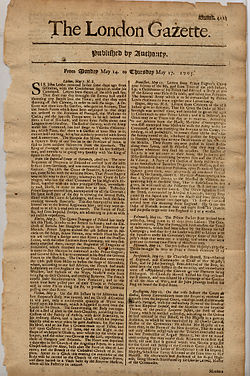The London Gazette

The London Gazette is one of the official journals of record of the British government, and the most important among such official journals in the United Kingdom, in which certain statutory notices are required to be published. The London Gazette claims to be the oldest surviving English newspaper and the oldest continuously published newspaper in the UK, having been first published on 7 November 1665 as the Oxford Gazette.[1] This title is also claimed by the Stamford Mercury and Berrow's Worcester Journal, because the Gazette is not a conventional newspaper offering general news coverage. It does not have a large circulation.
Other official newspapers of the UK government are the Edinburgh and Belfast Gazettes, which, apart from reproducing certain materials of nationwide interest published in the London Gazette, also contain publications specific to Scotland and Northern Ireland, respectively.
In turn, the London Gazette not only carries notices of UK-wide interest, but also those relating specifically to entities or people in England. However, certain notices that are only of specific interest to Scotland or Northern Ireland are also required to be published in the London Gazette.
The London, Edinburgh and Belfast Gazettes are published by TSO on behalf of Her Majesty's Stationery Office. They are subject to Crown Copyright.
Today
The London Gazette is published each weekday, except for Bank Holidays. Notices for the following, among others, are published:
- Granting of Royal Assent to bills of the Parliament of the United Kingdom or of the Scottish Parliament
- The issuance of writs of election when a vacancy occurs in the House of Commons
- Appointments to certain public offices
- Commissions in the Armed Forces and subsequent promotion of officers
- Corporate and personal insolvency
- Granting of awards of honours and military medals
- Changes of names or of coats of arms
- Royal Proclamations and other Declarations
Her Majesty's Stationery Office has digitised all issues which are available online.[2]
The official Gazettes are published by The Stationery Office.
History

The London Gazette was first published as the Oxford Gazette on 7 November 1665. Charles II and the Royal Court had moved to Oxford to escape the Great Plague of London, and courtiers were unwilling to touch, let alone read, London newspapers for fear of contagion. The Gazette was "Published by Authority" by Henry Muddiman, and its first publication is noted by Samuel Pepys in his diary. The King returned to London as the plague dissipated, and the Gazette moved too, with the first issue of the London Gazette (labelled No. 24) being published on 5 February 1666.[3] The Gazette was not a newspaper in the modern sense: it was sent by post to subscribers, not printed for sale to the general public.
In 1812 an officer of the London Gazette named George Reynell established the first advertising agency.[citation needed]
Her Majesty's Stationery Office took over the publication of the Gazette in 1889. Publication of the Gazette was transferred to the private sector, under government supervision, in the 1990s, when the bulk of HMSO was sold and renamed simply The Stationery Office.
"Gazetted"
- In time of war, dispatches from the various conflicts are published in the London Gazette. People referred to are said to have been mentioned in despatches. When members of the armed forces are promoted, and these promotions are published here, the person is said to have been “gazetted”.
- Being "gazetted" (or "in the gazette") sometimes also meant having official notice of one's bankruptcy published, as in the classic ten-line poem comparing the stolid yeomen of 1722 to the lavishly spending faux-genteel farmers of 1822[4]
- Man to the plough;
- Wife to the cow;
- Girl to the yarn;
- Boy to the barn;
- And your rent will be netted.
- Man tally-ho;
- Miss piano;
- Wife silk and satin;
- Boy Greek and Latin;
- And you'll all be Gazetted.
The phrase "gazetted fortune hunter" is also probably derived from this. Notices of engagement and marriage were also formerly published in the Gazette.
Colonial gazettes
There are equivalent government gazettes for the following current and former colonies or protectorates. They are available at the National Archives.
- Canada Gazette
- The Gazette of India
- Government Gazette of South Africa
- The New Zealand Gazette
- Hong Kong Government Gazette
See also
- Belfast Gazette in Northern Ireland
- Boletín Oficial del Estado in Spain
- Edinburgh Gazette in Scotland
- Iris Oifigiúil (which replaced the Dublin Gazette) in Ireland
- Official Journal of the European Union
- Diário da República in Portugal
- Federal Register in the United States
- Gazzetta Ufficiale in Italy
- Journal Officiel de la République Française
- Post- och Inrikes Tidningar in Sweden
- The Gazette of India
- The Royal Gazette (Thailand)
- OpenPSI for the OpenPSI project[7] which provides RDF and SPARQL end point of Gazette notice data
References
- ^ "No. 1". The Oxford Gazette. 7 November 1665.
- ^ Search the London Gazette Archive
- ^ "No. 24". The London Gazette. 5 February 1666.
- ^ By William Hone (1827); Published by Hunt and Clarke
- ^ Cyprus Government Gazette Retrieved 07 Nov 2010
- ^ Law Ministry The Gazette of India
- ^ Openpsi.org
External links
- London, Edinburgh and Belfast Gazettes
- Search over 5 million campaign medal cards on The UK National Archives' website, which contain references to The London Gazette.
- TSO (The Stationery Office)
